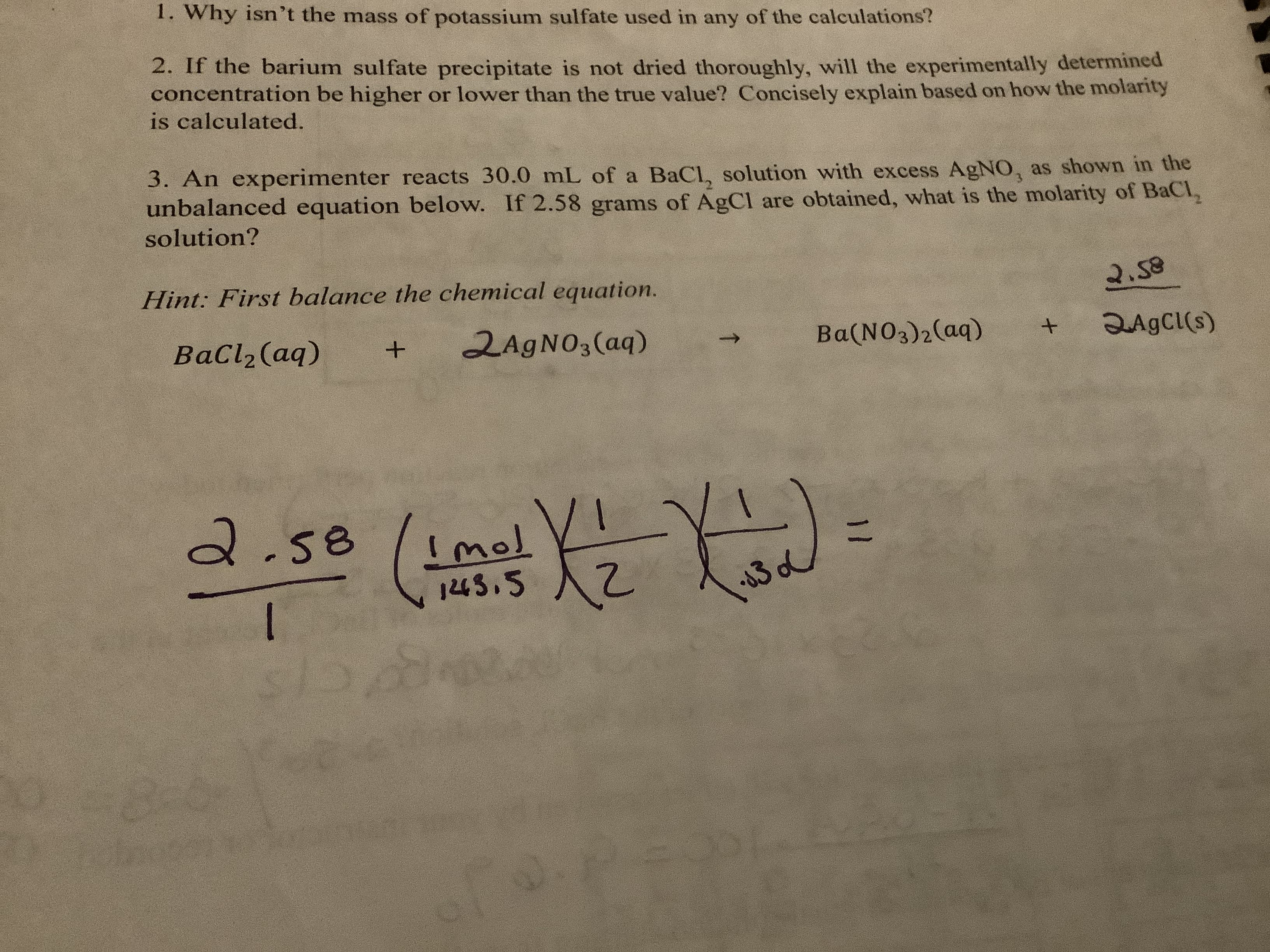1. Why isn't the mass of potassium sulfate used in any of the calculations? 2. If the barium sulfate precipitate is not dried thoroughly, will the experimentally determined concentration be higher or lower than the true value? Concisely explain based on how the molarity is calculated. 3. An experimenter reacts 30.0 mL of a BaCl, solution with excess AgNO, as shown in the unbalanced equation below. If 2.58 grams of AgCl are obtained, what is the molarity of BaCl solution? Hint: First balance the chemical equation. 2.S8 2AGNO3(aq) BaCl2 (aq) QAGCI(s) Ba(NO3)2(aq) a.se Imol 1243,5 I 07. 00 T
1. Why isn't the mass of potassium sulfate used in any of the calculations? 2. If the barium sulfate precipitate is not dried thoroughly, will the experimentally determined concentration be higher or lower than the true value? Concisely explain based on how the molarity is calculated. 3. An experimenter reacts 30.0 mL of a BaCl, solution with excess AgNO, as shown in the unbalanced equation below. If 2.58 grams of AgCl are obtained, what is the molarity of BaCl solution? Hint: First balance the chemical equation. 2.S8 2AGNO3(aq) BaCl2 (aq) QAGCI(s) Ba(NO3)2(aq) a.se Imol 1243,5 I 07. 00 T
Chemistry: Principles and Reactions
8th Edition
ISBN:9781305079373
Author:William L. Masterton, Cecile N. Hurley
Publisher:William L. Masterton, Cecile N. Hurley
Chapter4: Reactions In Aqueous Solution
Section: Chapter Questions
Problem 32QAP: A student tries to determine experimentally the molar mass of aspirin (HAsp). She takes 1.00 g of...
Related questions
Question
Question 3

Transcribed Image Text:1. Why isn't the mass of potassium sulfate used in any of the calculations?
2. If the barium sulfate precipitate is not dried thoroughly, will the experimentally determined
concentration be higher or lower than the true value? Concisely explain based on how the molarity
is calculated.
3. An experimenter reacts 30.0 mL of a BaCl, solution with excess AgNO, as shown in the
unbalanced equation below. If 2.58 grams of AgCl are obtained, what is the molarity of BaCl
solution?
Hint: First balance the chemical equation.
2.S8
2AGNO3(aq)
BaCl2 (aq)
QAGCI(s)
Ba(NO3)2(aq)
a.se
Imol
1243,5
I
07.
00
T
Expert Solution
This question has been solved!
Explore an expertly crafted, step-by-step solution for a thorough understanding of key concepts.
This is a popular solution!
Trending now
This is a popular solution!
Step by step
Solved in 5 steps with 4 images

Knowledge Booster
Learn more about
Need a deep-dive on the concept behind this application? Look no further. Learn more about this topic, chemistry and related others by exploring similar questions and additional content below.Recommended textbooks for you

Chemistry: Principles and Reactions
Chemistry
ISBN:
9781305079373
Author:
William L. Masterton, Cecile N. Hurley
Publisher:
Cengage Learning


Chemistry by OpenStax (2015-05-04)
Chemistry
ISBN:
9781938168390
Author:
Klaus Theopold, Richard H Langley, Paul Flowers, William R. Robinson, Mark Blaser
Publisher:
OpenStax

Chemistry: Principles and Reactions
Chemistry
ISBN:
9781305079373
Author:
William L. Masterton, Cecile N. Hurley
Publisher:
Cengage Learning


Chemistry by OpenStax (2015-05-04)
Chemistry
ISBN:
9781938168390
Author:
Klaus Theopold, Richard H Langley, Paul Flowers, William R. Robinson, Mark Blaser
Publisher:
OpenStax

Introductory Chemistry: A Foundation
Chemistry
ISBN:
9781337399425
Author:
Steven S. Zumdahl, Donald J. DeCoste
Publisher:
Cengage Learning


Chemistry
Chemistry
ISBN:
9781305957404
Author:
Steven S. Zumdahl, Susan A. Zumdahl, Donald J. DeCoste
Publisher:
Cengage Learning